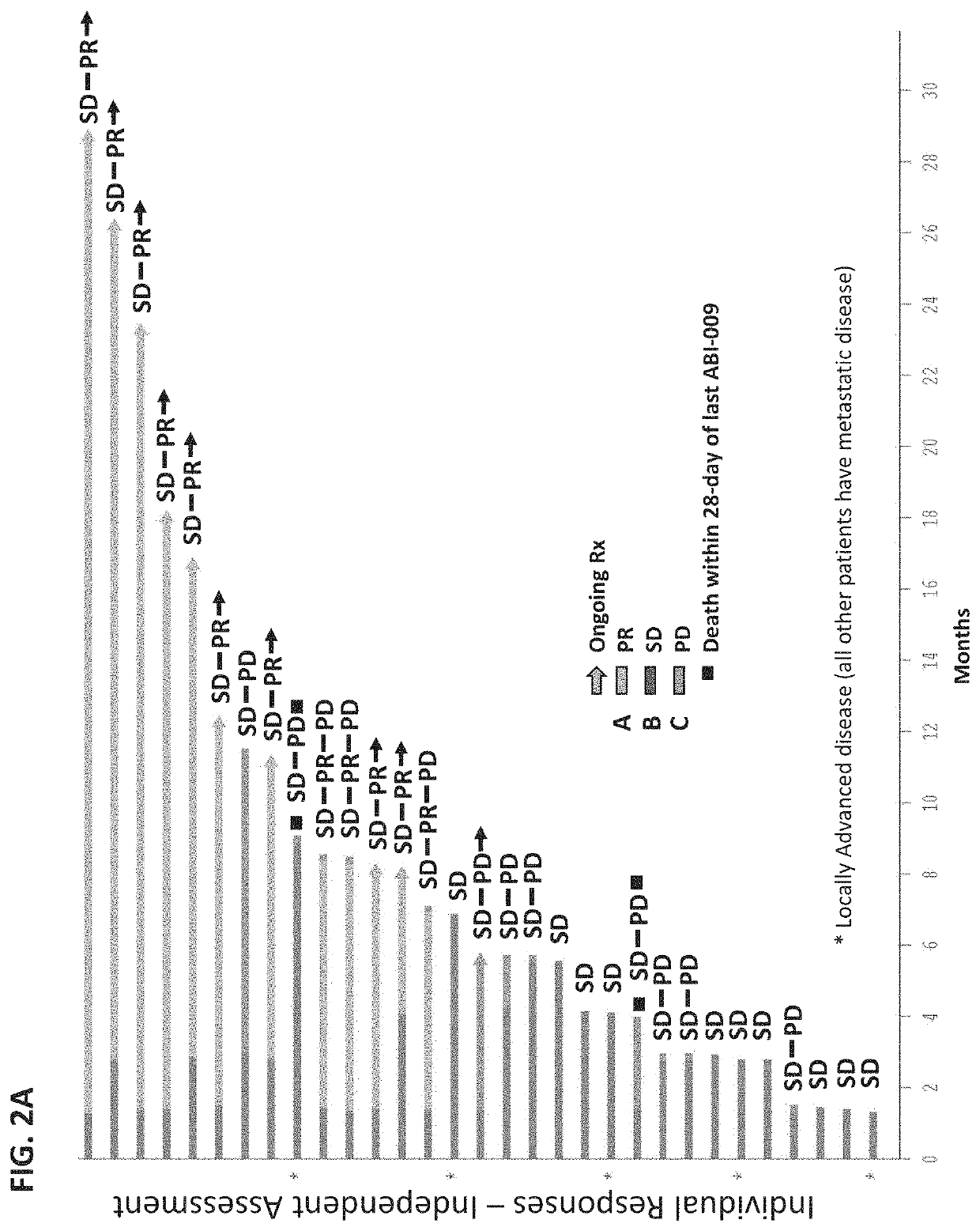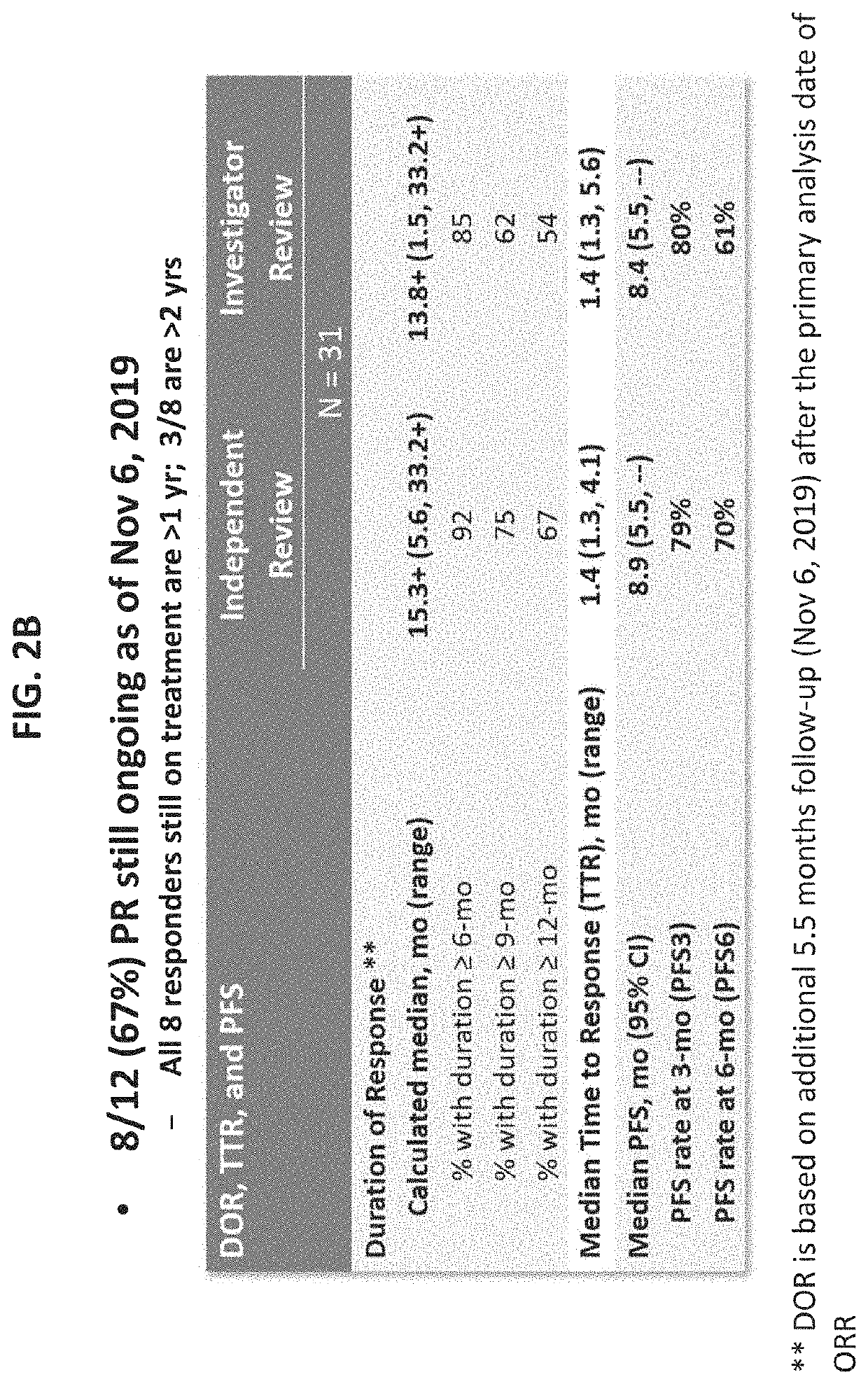Biomarkers for nanoparticle compositions
a nanoparticle and composition technology, applied in the direction of drug compositions, heterocyclic compound active ingredients, microcapsules, etc., can solve the problems of tsc1/2 and mtor mutations in responding to rapalogs, and the variability of treatment response among different individuals with the same diseas
- Summary
- Abstract
- Description
- Claims
- Application Information
AI Technical Summary
Benefits of technology
Problems solved by technology
Method used
Image
Examples
example 1
Study Multi-Center Study with Patients Receiving ABI-009 Treatment
[0448]Patients with advanced malignant PEComa (a rare, aggressive sarcoma, with no approved treatment available) who previously have not been treated with an mTOR inhibitor were enrolled in a phase II study, single arm, open label, multi-institutional study to assess the efficacy and safety profile of intravenous ABI-009 (also referred to herein as nab-sirolimus or nab-rapamycin, produced as described in Example 7).
[0449]Key eligibility requirements include that patients a) were at least 18 years old at the time of enrollment, b) had Eastern Cooperative Oncology Group (ECOG) performance status 0 or 1, c) had histological confirmation of a PEComa; d) had locally advanced inoperable or metastatic disease; and 3) had no prior treatment with an mTOR inhibitor.
[0450]Patients received ABI-009 at a dose of 100 mg / m2 for two of every 3 weeks by IV infusion over 30 minutes. Two dose reduction levels were allowed: 75 mg / m2 and ...
example 2
PEComa Patient Who had Failed Prior mTOR Inhibitor Responded to ABI-009
[0474]A58-year-old post-menopausal female with family history of lymphoma in her father and breast, ovarian cancer in a paternal aunt, presented with abnormal uterine bleeding in 7 / 2018. Endometrial biopsy revealed a neoplastic process and further work up with CT scan showed a 7 cm mass. Following this, a laparoscopic hysterectomy with bilateral salpingo-oophorectomy was performed and pathology was consistent with malignant PEComa which stained positive for smooth muscle actin, HMB-45 and Melan-A (59 mitoses per 10 hpf). FoundationOne genomic testing revealed a TSC1 mutation with stable micro satellite status and low tumor mutation burden.
Treatment History
[0475]The primary tumor was locally advanced, and no metastatic disease was present at the time of diagnosis, adjuvant chemotherapy was not administered, and the patient was monitored with serial scans. A CT scan at 6 months in February of 2019 (FIG....
example 3a
ient Who Failed Sirolimus Achieved a Stable Disease after Administration of ABI-009
[0480]A patient with PEComa metastatic to lung previously treated with sirolimus and progressed. A mutational analysis on the tumor sample (Left diaphragmatic mass with greater omentum) using the IMPACT NGS panel revealed the following somatic mutations:[0481]1. TSC2 Nonsense Mutation Y648* (c. 1944C>A) exon 18 Mutant allele frequency (MAF): 82.3%[0482]2. TP53 Missense Mutation Y220C (c.659A>G) exon 6 MAF: 81.2%[0483]3. ATRX Frameshift Deletion K1646Mfs*10 (c.4937_4940del) exon 18 MAF: 72.1%[0484]4. The estimated tumor mutation burden (TMB) for this sample is 4.4 mutations per megabase (mt / Mb).[0485]5. MSI Status: MICROSATELLITE STABLE (MSS).
[0486]Additionally the following somatic mutation was detected in the blood[0487]1. DNMT3A Splicing X492_splice (c.1474+1G>A) exon 12 MAF: 2.3%[0488]2. DNMT3A Splicing X492_splice (c.1474+1del) exon 12 MAF: 1.4%
[0489]The patient was started on nab-sirolimus 100 mg...
PUM
| Property | Measurement | Unit |
|---|---|---|
| diameter | aaaaa | aaaaa |
| multiple angle light scattering | aaaaa | aaaaa |
| size- | aaaaa | aaaaa |
Abstract
Description
Claims
Application Information
 Login to View More
Login to View More - R&D
- Intellectual Property
- Life Sciences
- Materials
- Tech Scout
- Unparalleled Data Quality
- Higher Quality Content
- 60% Fewer Hallucinations
Browse by: Latest US Patents, China's latest patents, Technical Efficacy Thesaurus, Application Domain, Technology Topic, Popular Technical Reports.
© 2025 PatSnap. All rights reserved.Legal|Privacy policy|Modern Slavery Act Transparency Statement|Sitemap|About US| Contact US: help@patsnap.com



